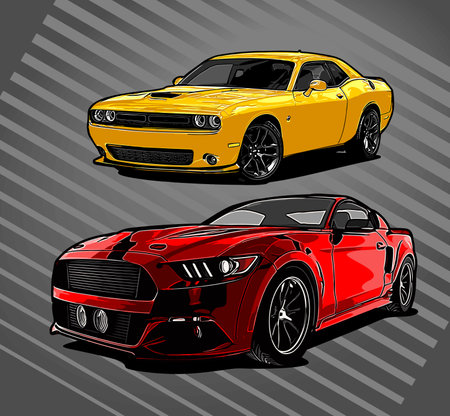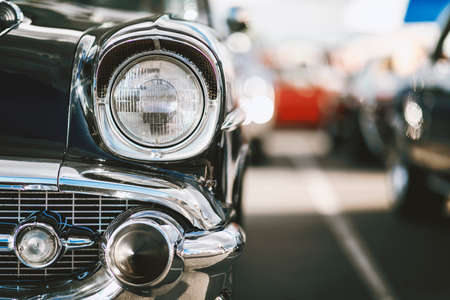1. Introduction: The Rise of Car Culture in America
Car culture in America is more than just a hobby—it’s a lifestyle and a reflection of the nation’s love affair with automobiles. From the early days of manufacturing to the modern-day intersection of technology and design, cars have played a significant role in shaping American identity. This passion for automobiles set the stage for the formation of car clubs, which emerged as tight-knit communities of enthusiasts sharing their love for different types of vehicles.
Early Automotive Influence
At the beginning of the 20th century, cars were a luxury that only a few could afford. However, Henry Ford’s introduction of the Model T in 1908 revolutionized transportation, making cars accessible to the average American. As more people became drivers, the role of automobiles in society expanded beyond practical transportation.
Post-War Boom and the Birth of Car Enthusiasm
After World War II, America experienced an economic boom, leading to an increase in disposable income and automobile ownership. Veterans returned home with a new appreciation for engineering and mechanics, which fueled their interest in customizing and modifying their cars. This era also saw the rise of hot rods, muscle cars, and the early formation of car clubs, as enthusiasts gathered to share tips, compete, and showcase their vehicles.
The Growth of Car Clubs
During the 1950s and 1960s, car clubs became more structured and widespread. These clubs often organized racing events, meetups, and road trips, fostering a strong sense of community among members. Over time, car culture diversified, leading to the formation of clubs catering to specific brands, models, or types of modifications.
Key Developments in Early American Car Culture
| Era | Major Influence | Impact on Car Culture |
|---|---|---|
| 1900s-1910s | Model T and Mass Production | Increased car ownership and accessibility |
| 1930s-1940s | Post-War Engineering Knowledge | Rise of car modifications and early hot rods |
| 1950s-1960s | Muscle Cars and Street Racing | Growth of organized car clubs |
Setting the Stage for Car Clubs
As car culture became deeply ingrained in American society, enthusiasts sought out others who shared their passion. Whether it was racing, restoring, or simply cruising, car clubs provided a way for like-minded individuals to connect, paving the way for the diverse and vibrant club scene that continues to thrive today.
2. The Hot Rod Era: Birth of Car Clubs
After World War II, America saw a major shift in car culture. Soldiers returning home had hands-on mechanical skills and a passion for speed. With affordable surplus parts and old cars available, the hot rod movement began to take shape. This led to the birth of the first car clubs, where enthusiasts gathered to modify, race, and show off their custom-built machines.
The Influence of WWII on Hot Rodding
Many soldiers developed mechanical experience during the war, working on tanks, planes, and military vehicles. When they returned, they applied these skills to civilian cars, modifying engines and stripping weight to make them faster. At the same time, American industries shifted from war production to consumer goods, making car parts more accessible.
Early Car Clubs and Their Purpose
As hot rodding gained popularity, enthusiasts began forming car clubs to share knowledge, compete in races, and showcase their work. These clubs played a key role in shaping the growing automotive community. Some of the earliest car clubs focused on safety, encouraging organized racing instead of dangerous street racing. Others were dedicated to specific types of vehicles or mechanical modifications.
Examples of Early Car Clubs
| Club Name | Founded | Purpose |
|---|---|---|
| The Road Runners | 1940s | Organized legal racing events |
| The Throttle Stompers | 1950s | Focused on extreme hot rod modifications |
| The Gear Grinders | 1940s | Mechanic and technical knowledge sharing |
Impact on American Car Culture
These early car clubs did more than just bring together car lovers—they helped lay the foundation for the modern automotive enthusiast community. Clubs held organized drag races, worked on improving vehicle performance, and even helped shape the rules for official racing organizations like the NHRA (National Hot Rod Association). This era of hot-rodding set the stage for modern car culture, influencing everything from street racing to today’s custom car scene.

3. Muscle Cars and the Expansion of Car Clubs
During the 1960s and 1970s, the rise of muscle cars ignited a new wave of excitement among car enthusiasts. These high-performance, American-made vehicles with powerful V8 engines quickly gained popularity, leading to a boom in car clubs across the U.S. People who owned and loved cars like the Ford Mustang, Chevrolet Camaro, and Dodge Challenger formed communities to share their passion. This era also saw an increase in organized racing events, car meetups, and a deepening sense of brand loyalty.
The Muscle Car Mania
Muscle cars stood out because of their powerful engines, aggressive styling, and accessibility. Unlike expensive sports cars, muscle cars were affordable for the average American, making them especially popular among younger drivers. This era saw the birth of legendary models, and car clubs formed as a way for owners to connect, exchange performance tips, and showcase their modified rides.
Popular Muscle Cars of the Era
| Car Model | Engine Options | Notable Features |
|---|---|---|
| Ford Mustang | 289, 302, 351, 428 V8 | Iconic pony car, Shelby GT models |
| Chevrolet Camaro | 302, 327, 350, 396 V8 | Z/28 performance model, RS/SS packages |
| Dodge Charger | 383, 426 HEMI, 440 Magnum | Fastback design, General Lee from “Dukes of Hazzard” |
| Pontiac GTO | 389, 400, 455 V8 | Considered the first muscle car, “The Judge” edition |
Growth of Car Clubs and Events
As muscle cars became more popular, local and national car clubs started forming. These clubs provided a space for gearheads to bond over their shared enthusiasm. Some groups focused on specific brands, like Mustang-only clubs, while others welcomed all muscle car owners. Organized drag racing events, car shows, and cruise nights became regular occurrences, giving members a chance to showcase their rides in a competitive but friendly environment.
Iconic Racing and Meetups
With more horsepower on the streets, enthusiasts sought out legal ways to test their cars limits. Drag strips became hotspots, with famous locations like Detroit’s Woodward Avenue and California’s Lions Drag Strip hosting regular events. Club members participated in these races to prove their vehicle’s performance, often fine-tuning their engines for maximum speed. Car meetups also became a tradition, where enthusiasts could show off their rides, swap parts, and trade stories.
The Rise of Brand Loyalty
Owning a muscle car wasnt just about driving—it was about representing a brand. Ford, Chevrolet, Pontiac, and Dodge all had dedicated followings. This brand loyalty often sparked friendly rivalries between clubs, especially among Mustang, Camaro, and Charger owners. Car manufacturers took notice and began marketing directly to enthusiasts, sponsoring racing events and creating performance packages specifically tailored for street racing and track competition.
By the end of the 1970s, muscle cars and their loyal followings had firmly established their place in American car culture. Car clubs continued to grow, providing a strong sense of community and a lasting legacy that still influences modern car enthusiasts today.
4. The Rise of Import Tuning and Customization
During the 1980s and 1990s, Japanese cars began to make a major impact on the American automotive scene. Affordable, lightweight, and highly tunable models like the Honda Civic, Toyota Supra, and Nissan 240SX became favorites among young car enthusiasts. Unlike the classic American muscle and hot rod culture that focused on raw power and V8 engines, this new wave of car culture emphasized precision tuning, aerodynamics, and technology-driven performance enhancements.
The Impact of Japanese Imports
Prior to the rise of import tuning, American car clubs were mostly centered around domestic brands like Ford, Chevrolet, and Dodge. However, the arrival of Japanese sports cars introduced a new enthusiast crowd. Car enthusiasts embraced vehicles that were efficient yet capable of impressive performance with the right upgrades. Japanese automakers also supported this tuning culture by offering performance-focused models with easily modifiable engines and chassis.
Street Racing and the Tuning Scene
Street racing became a defining element of the import tuning scene during the 1990s. Inspired by the illegal night racing culture from Japan, young enthusiasts in cities like Los Angeles and New York would gather in parking lots before racing through urban streets late at night. While dangerous and illegal, these underground events played a crucial role in growing the scene, leading to the eventual rise of organized competitions like drag racing and autocross.
The Shift Toward Performance Tuning
The focus of import tuning shifted from purely cosmetic modifications to serious performance upgrades. Enthusiasts began investing in turbochargers, suspension upgrades, and ECU tuning to maximize power and handling. Below is a comparison of key tuning aspects in the hot rod era versus the import tuning era:
| Aspect | Hot Rod Era | Import Tuning Era |
|---|---|---|
| Engine Focus | Big-block V8s | High-revving inline-4s, turbocharged engines |
| Customization Style | Chopped tops, flaming paint jobs | Carbon fiber body kits, LED lighting |
| Performance Mods | Carburetors, headers, superchargers | Turbo kits, ECU tuning, widebody kits |
| Racing Influence | Drag racing on rural roads | Street racing, time attack, drifting |
The Lasting Legacy
Import tuning has evolved into a major segment of car culture today, influencing everything from mainstream automotive designs to professional motorsports. With the rise of digital tuning and aftermarket support, modern enthusiasts continue to improve and customize their cars, carrying on the legacy of the 80s and 90s tuning scene.
5. Modern Car Enthusiasts: Social Media and Beyond
In the 21st century, the way car enthusiasts connect and form clubs has drastically changed. With the rise of digital platforms and social media, car culture has become more accessible than ever. No longer limited to local meetups and physical gatherings, enthusiasts now have endless opportunities to engage with like-minded individuals worldwide.
The Impact of Social Media on Car Culture
Social media platforms like Instagram, Facebook, and YouTube have revolutionized car clubs. Enthusiasts can now showcase their builds, share car-related content, and even organize events with a global audience. Hashtags and online trends have further helped niche car communities grow.
Popular Social Media Platforms for Car Enthusiasts
| Platform | How Its Used |
|---|---|
| Sharing car photos, reels, and builds using hashtags | |
| Joining car groups, event organization, and discussions | |
| YouTube | Creating in-depth car reviews, DIY tutorials, and vlogs |
| Engaging in detailed discussions on specific car models and mods |
Online Forums and Virtual Communities
Before social media, online forums were the go-to space for car discussions. While platforms like Facebook and Reddit have taken over, some dedicated forums, such as NASIOC for Subaru enthusiasts and Mustang6G for Mustang owners, remain popular.
The Role of Apps and Live Streaming
New technology has also played a role in modernizing car clubs. Apps like Discord allow enthusiasts to voice chat and share real-time updates, while live streaming on Twitch and YouTube lets people experience car meets and races from their homes.
Advantages of Digital Car Communities
- Access to worldwide connections
- Easier event organization
- Instant sharing of car content and knowledge
- Opportunities to collaborate with brands and influencers
The Future of Car Clubs in a Digital Age
As technology continues to advance, the way car enthusiasts interact will keep evolving. Whether through VR car meets or AI-powered customization tools, the role of digital platforms in car culture will only expand, shaping the future of automotive communities.


